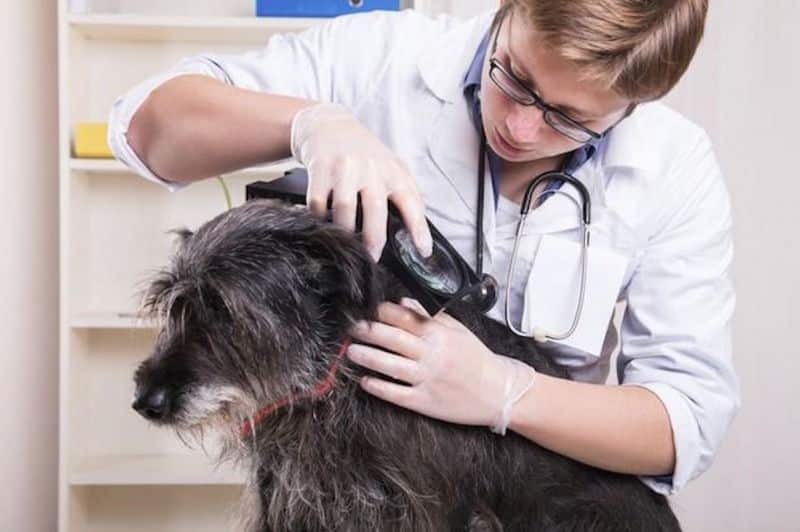When it comes to allergies, humans aren’t the only ones who suffer. Our canine companions are also prone to be affected by allergies, which can be airborne, environmental, seasonal, or food related.
In fact, if you have ever noticed your dog licking its paws, sneezing excessively, or scratching its ears, you have probably seen the symptoms that allergies can cause first hand.
Although the majority of dogs experience environmental allergies (from irritants found both indoors and outdoors), dogs can also have food allergies that manifest themselves in much the same way.
If you are worried that your dog may be suffering from allergies, be aware that it is a very common problem, and read on to help you determine the best course of action to take. There are many tests that can be done to determine the problem and even more options for treatment.
This article will discuss the signs and symptoms of allergies in your dog, the root cause of allergies, the different types of allergies most common in canines, and options for dog allergy testing and treatment for your dog.
Does My Dog Have Allergies?
Many pet parents find themselves asking this question once their pet begins exhibiting any of the following behaviors or physical conditions:
- Scratching, biting, and licking paws;
- Restlessness and anxiety;
- Runny or watery eyes;
- Constant licking;
- Ear infections;
- Hair loss (especially in areas where itching may be the most severe such as the side, under the arms, elbows and the groin area);
- Shaking head excessively or rubbing face against the furniture or floor;
- Scratching of face and body;
- Hot spots—which are moist sores that are red and can become easily infected;
- Gastrointestinal issues or diarrhea.
If your dog has been displaying any of the above behaviors, it is very likely that he is suffering from allergies. However, don’t be too quick to write off your dog’s symptoms as “just allergies” and let a more serious problem go undiagnosed.
Serious health concerns such as mange, skin tumors, bacterial infections, immune disorders, and yeast infections all have very similar symptoms to allergies. Of course, only a veterinarian can officially diagnose your dog, but you can first try to determine what type of allergies your dog may have.
Types of Most Common Allergies in Dogs
1. Atopy Allergies
Atopy, or airborne, allergies are the most common type of allergies in dogs. The good news is that many types of airborne allergens are seasonal. The bad news is that every season brings a new allergen. In the winter, when pets spend more time indoors, allergens can include dust mites, mold, and feathers.
Outdoors, each month brings new allergens: springtime brings tree pollens (such as oak, pine, and birch), summer brings a variety of grass pollens, and autumn brings ragweed and other weeds. To further the problem, many dogs track pollens back indoors where they continue to be inhaled.

Humans, of course, have airborne allergies as well, but symptoms typically manifest themselves in the form of sneezing and itchy, watery, and red eyes. While dogs can also exhibit these symptoms, scratching and licking (particular of the paws) is the most common symptom.
2. Contact Allergy
The least common allergy present in canines is contact allergy—the cause of which is usually attributed to household cleaners, detergents, perfumes, chemicals, plastics, and carpet cleaners. Whereas airborne allergies are caused by the microscopic particles that are inhaled by canines (and humans), contact allergies occur when the skin itself has a reaction to the chemicals found in these manufactured items (although dogs have been known to have an allergic reaction to grass and other naturals products).
Scratching and licking can be a sign that your dog may have a contact allergy, but the hallmark symptom is a red rash.
3. Food Allergy

Food allergies, while not as common as airborne allergies, can still present problems for your dog. Many pet owners can overlook the possibility of a food allergy because dogs can develop an allergy to food over time. So while Fido might have been doing perfectly fine on a particular brand, that doesn’t necessarily mean that particular food will not cause problems in the future.
Additionally, many pet owners confuse the more common issue of food intolerance with the not-so-common food allergy. The former is a digestive problem when a dog’s digestive system simply cannot tolerate (or digest) a certain ingredient in the food.
The symptoms of food intolerance are more likely to include gas, bloating, vomiting, and upset stomach. The latter—food allergy—is an immune response that occurs when the immune system identifies a certain ingredient as harmful, which in turn causes the body to create antibodies to defend the body from the offending ingredient. Dogs with food allergies exhibit much of the same symptoms that are typically associated with airborne allergies, such as scratching and licking, so diagnosis can be a long process.
Food allergies only account for 10% of allergies in dogs, but pet owners should still strive to feed their dogs quality food. However, feeding your dog a high-end, expensive food does not necessarily mean that your dog will not have an allergic reaction.
In fact, the most common ingredients that dogs are allergic to include chicken, beef, and dairy, and fish (although many dogs can also develop an allergy to corn, wheat, and other grains). Many high-end dog foods offer limited-ingredient varieties, which would certainly make is easier to pinpoint the offending ingredient (discussed more below).
Containments found in food are another cause for food allergies, particularly if the food contains cheap grains such as corn and wheat, because grain insects (such as beetles, mites, and weevils) can feed on the grains in the food, and their carcasses (and droppings) are frequently found in low-end dog foods.
Other containments that have been the reason for major dog-food recalls have included melamine, salmonella, listeria, and even rat poison. Cross-contamination can occur in any brand of dog-food, but there certainly seems to be a link between low quality (and therefore low price) dog food and recalls.
4. Flea Allergy
A common misbelief about flea allergies in dogs is the cause. Believe it or not, it is not the flea itself that is causing the allergy, it is the flea’s saliva; just as humans are allergic to mosquito saliva and not the mosquito itself. Many dog owners falsely believe that their dog couldn’t possibly have a flea allergy if the dog is not infested with the biting animals, but the truth is that the bite from just one or two fleas can be enough to induce an allergic response.

Since fleas are difficult to see with the naked eye (especially if your dog has a long or thick coat), it can be difficult to diagnose this specific type of allergy.
Veterinarian’s Diagnosis
If you are concerned that your dog may have allergies, a trip to a qualified veterinarian is in order. It can be difficult to pinpoint the root cause of the allergy, and the series of questions your vet will ask will help to narrow the field. You can expect to be asked:
- How long have the symptoms been occurring?
- What behavior(s) does your dog exhibit that make you think he has allergies?
- What time the year do the symptoms generally occur?
- What events (if any) took place before you noticed a change in your dog’s behavior (such as a new environment, change in diet, or time spent indoors/outdoors)?
Based on your answers, your veterinarian will advise you on your options. If your vet believes that your dog is suffering from (the most common) issue of airborne allergies, he may want to do an allergy test to identify the allergen(s). Similar to tests performed on humans for the same reason, allergy tests can include serum testing or intradermal testing. Serum testing includes a blood draw that is sent off to a laboratory for evaluation, while intradermal tests are performed by a veterinarian dermatologist and will test for allergens that are most common to your geographic location.
Allergy testing can test for more than 60 allergens, including dust, ants, flies, cotton, feathers, wool, pollens, and over a dozen types of mold. Your vet may also perform a skin-scraping test in the office that can rule out a flea allergy.

For food allergies, however, the most popular method of diagnosing dogs is an elimination diet. While intradermal and serum testing are very efficient at identifying environmental allergens, the same cannot be said of food allergies.
Your vet will provide you instructions on how to perform an elimination diet, but your can expect to remove all familiar food from your dog’s current diet (including all treats, rawhide bones, and flavored medications) for around 12 weeks and instead start from scratch with a meal of a simple protein and a carbohydrate.
Vets usually prefer for dogs to be given a protein that they have not been previously offered, such as rabbit or fish, in case a common protein, such as chicken, is the offending ingredient. Slowly, you will begin adding certain ingredients back into your dog’s diet, which will help you to determine what your dog is allergic to.
Treatments and Medications
Once your dog has received a diagnosis, your veterinarian can direct you on your options. When it comes to allergies in dogs, the key is prevention. If your dog is allergic to grasses and pollens outdoors, you will want to limit your dog’s time spent outside, especially in peak pollen season.
If your dog is allergic to indoor pollutants such as dust, mold, and cigarette smoke, invest in a HEPA filter for your home and make a commitment to vacuum often and only smoke outdoors.
Washing pet’s bedding often is also key in preventing allergies. For a flea allergy, the key again is prevention. Be sure to stay up to date on your dog’s monthly heartworm medication as well as using a topical medication to prevent fleas and ticks from biting your dogs. Flea collars are another, less expensive option that is effective in preventing fleas from laying eggs in your dog’s coat.
While not solving the actual problem, many pet owners find that simply treating the symptoms can provide their dog with much needed relief. Try a weekly bath to remove allergens from your dog’s coat.

You can find special shampoos in your local pet store or online that are specially made for this purpose. Additionally, try rinsing your dog’s paws off when he comes indoors to remove excess pollen from being tracked back inside. Brushing your dog and even applying cold water to the affected areas can provide him with relief.
If your dog is allergic to airborne allergens, your vet may recommend allergy shots—especially if you live in a climate where it is warm and humid the majority of the year. While a successful option for some pet owners, a large percentage of pet parents feel that allergy shots are an expensive option without guarantees. As many as 1/3 of dogs may not respond to allergy shots (also called hyposensization).
In fact, most dogs take several months to begin responding to the treatment, and the shots must be continued indefinitely in order to be effective. Allergy shots, which can usually be administered by the owner, can run several hundred dollars a year, which is in addition to the cost of the allergy testing that must be completed beforehand.
For food allergies, the answer is clear: once the allergen is identified, select a dog food that does not contain the specific ingredient(s) that your dog is allergic to. Many pet owners find that making their own dog food is a smart and less and expensive option and many “recipes” can be found online.
Additionally, there are many hypoallergenic dog foods on the market or foods that include novel ingredients that do not typically cause allergic reaction. For dogs that have food allergies, owners must always monitor the type of treats that their dog is being offered, especially in a public places like dog parks.
Steroids are another treatment option for severe cases, though most veterinarians don’t recommend extended use of steroid shots. Steroids work by controlling inflammation, (similar to cortisone shots), but they “turn off” a dog’s immune system. So while this could provide temporary relief from allergy symptoms, it can come with a disturbing laundry list of side effects that can range from increased hunger and thirst to diabetes.
Most veterinarians agree that while steroids may help your dog in the short term, real relief will only come from treating the root cause and not attempting to cover up the symptoms.
There are plenty of other treatment options available, which you can find here in our article about treating dog allergies quickly and efficiently.
For a more holistic treatment plan, you can try supplementing your dog’s diet with fatty acids. Omega-3 fatty acids help control inflammation, and these essential fatty acids are found in fish oils.
After consulting with your veterinarian first, try adding krill oil or fish oil to your dog’s food. Fatty acids can also be purchased in a variety of pill forms and capsules, and many owners give their dogs canned or fresh cooked fish as a weekly treat. Keep in mind that it can take several weeks for your dog to respond and make improvements.
There are plenty of other holistic approaches to dealing with your dog’s allergies. If you’d like to learn more about what those are, we have a great article you should check out about natural home remedies for dog allergies.
A Note on Certain Breeds
Some experts believe that airborne allergies are an inherited trait, so if you are in the market for a pet to add to your family, be aware that certain breeds are more prone to suffer from allergies than others. The breeds that are most sensitive to allergies include terriers, retrievers and flat faced breeds such as pugs and bulldogs.
If you’d like to know what other environmental and genetic factors affect your dog’s allergies, please read our wonderful article on common dog allergies.
However, even mixed breed dogs can suffer from allergies, so whether you have a purebred pup or a mutt, there is no guarantee of their predisposition to allergies. To add to the problem, most dogs don’t even begin to show symptoms of allergies until after they are one year old, so don’t be lulled into a false sense of security if your puppy has no problems before one year of age.
Many pet owners may have been previously unaware that dogs can have allergies, but it is actually a very common problem, affecting up to 15% of dogs. There are many treatment options that range from prevention to holistic therapy, and from passive observation to aggressive treatment. The first step is to visit your veterinarian to determine what type of allergies your dog may be suffering from so you can come up with a treatment plan together.
Perhaps one of the most frustrating aspects of trying to figure out if your dog has allergies is the fact that we can’t ask our canine friends what it ailing them, but while our dogs may not be able to speak to us and tell us they are in uncomfortable or are in pain, it is our responsibility as pet owners to properly care for our canine companions so they can have a long and healthy life.




